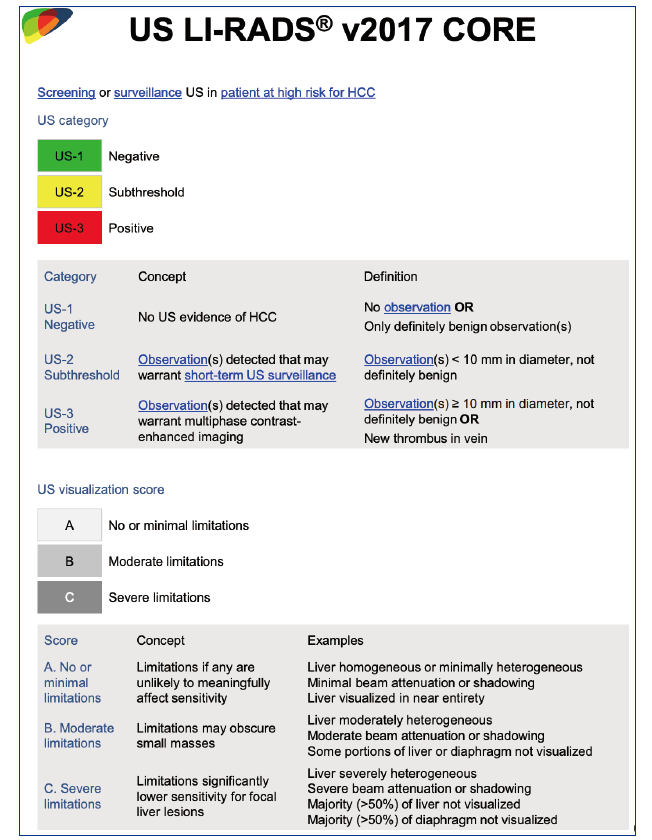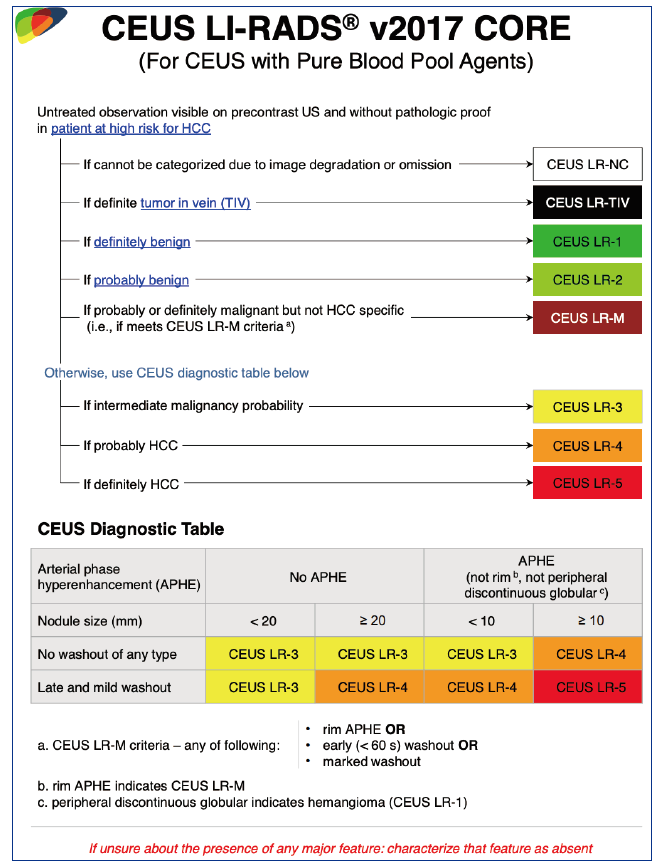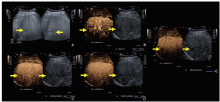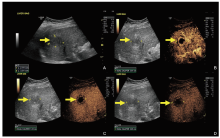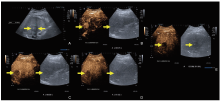| [1] |
Rumgay H, Arnold M, Ferlay J, Lesi O, Cabasag CJ, Vignat J, et al. Global burden of primary liver cancer in 2020 and predictions to 2040. J Hepatol 2022; 77:1598-1606.
doi: 10.1016/j.jhep.2022.08.021 pmid: 36208844 |
| [2] |
Ding J, Long L, Zhang X, Chen C, Zhou H, Zhou Y, et al. Contrast-enhanced ultrasound LI-RADS 2017: Comparison with CT/MRI LI-RADS. Eur Radiol 2021; 31:847-854.
doi: 10.1007/s00330-020-07159-z |
| [3] |
Tan Z, Teoh WC, Wong KM, Wansaicheong GK, Sandrasegaran K. Analysis of comparative performance of CEUS and CECT/MR LI-RADS classification: Can CEUS dichotomize LI-RADS indeterminate lesions on CT or MRI? Clin Imaging 2020; 62:63-68.
doi: 10.1016/j.clinimag.2020.02.002 |
| [4] |
Golabi P, Fazel S, Otgonsuren M, Sayiner M, Locklear CT, Younossi ZM. Mortality assessment of patients with hepatocellular carcinoma according to underlying disease and treatment modalities. Medicine (Baltimore) 2017; 96:e5904.
doi: 10.1097/MD.0000000000005904 |
| [5] | Tunissiolli NM, Castanhole-Nunes MMU, Biselli-Chicote PM, Pavarino EC, da Silva RF, da Silva RC, et al. Hepatocellular carcinoma: A comprehensive review of biomarkers, clinical aspects, and therapy. Asian Pac J Cancer Prev 2017; 18:863-872. |
| [6] | American College of Radiology. LI-RADS® CEUS v2017 | American College of Radiology. https://www.acr.org/-/media/ACR/Files/RADS/LI-RADS/CEUS-LI-RADS-2017-Core.pdf |
| [7] |
Wilson SR, Lyshchik A, Piscaglia F, Cosgrove D, Jang HJ, Sirlin C, et al. CEUS LI-RADS: algorithm, implementation, and key differences from CT/MRI. Abdom Radiol (NY) 2018; 43:127-142.
doi: 10.1007/s00261-017-1250-0 pmid: 28819825 |
| [8] |
Eisenbrey JR, Gabriel H, Savsani E, Lyshchik A. Contrast-enhanced ultrasound (CEUS) in HCC diagnosis and assessment of tumor response to locoregional therapies. Abdom Radiol (NY) 2021; 46:3579-3595.
doi: 10.1007/s00261-021-03059-y pmid: 33825927 |
| [9] | Morgan TA, Maturen KE, Dahiya N, Sun MRM, Kamaya A. US LI-RADS: Ultrasound liver imaging reporting and data system for screening and surveillance of hepatocellular carcinoma. Abdom Radiol (NY) 2018; 43:41-55. |
| [10] |
Chen LD, Ruan SM, Lin Y, Liang JY, Shen SL, Hu HT, et al. Comparison between M-score and LR-M in the reporting system of contrast-enhanced ultrasound LI-RADS. Eur Radiol 2019; 29:4249-4257.
doi: 10.1007/s00330-018-5927-8 pmid: 30569182 |
| [11] | Li CQ, Huang H, Ruan SM, Hu HT, Xian MF, Xie XY, et al. An assessment of liver lesions using a combination of CEUS LI-RADS and AFP. Abdom Radiol (NY) 2022; 47:1311-1320. |
| [12] | Zheng W, Li Q, Zou XB, Wang JW, Han F, Li F, et al. Evaluation of contrast-enhanced US LI-RADS version 2017: Application on 2020 liver nodules in patients with hepatitis B infection. Radiology 2020; 294:299-307. |
| [13] |
Lyshchik A, Kono Y, Dietrich CF, Jang HJ, Kim TK, Piscaglia F, et al. Contrast-enhanced ultrasound of the liver: technical and lexicon recommendations from the ACR CEUS LI-RADS working group. Abdom Radiol (NY) 2018; 43:861-879.
doi: 10.1007/s00261-017-1392-0 pmid: 29151131 |
| [14] |
Hu YX, Shen JX, Han J, Mao SY, Mao RS, Li Q, et al. Diagnosis of non-hepatocellular carcinoma malignancies in patients with risks for hepatocellular carcinoma: CEUS LI-RADS Versus CT/MRI LI-RADS. Front Oncol 2021; 11:641195.
doi: 10.3389/fonc.2021.641195 |
| [15] |
Liu W, Qin J, Guo R, Xie S, Jiang H, Wang X, et al. Accuracy of the diagnostic evaluation of hepatocellular carcinoma with LI-RADS. Acta Radiol 2018; 59:140-146.
doi: 10.1177/0284185117716700 pmid: 28648125 |
| [16] |
Terzi E, Iavarone M, Pompili M, Veronese L, Cabibbo G, Fraquelli M, et al. Contrast ultrasound LI-RADS LR-5 identifies hepatocellular carcinoma in cirrhosis in a multicenter retrospective study of 1,006 nodules. J Hepatol 2018; 68:485-492.
doi: 10.1016/j.jhep.2017.11.007 |
| [17] |
Bartolotta TV, Terranova MC, Gagliardo C, Taibbi A. CEUS LI-RADS: a pictorial review. Insights Imaging 2020; 11:9.
doi: 10.1186/s13244-019-0819-2 |
| [18] |
Kim DH, Choi SH, Park SH, Kim KW, Byun JH, Kim SY, et al. The Liver Imaging Reporting and Data System tumor-in-vein category: A systematic review and meta-analysis. Eur Radiol 2021; 31:2497-2506.
doi: 10.1007/s00330-020-07282-x |
| [19] |
Nguyen SA, Merrill CD, Burrowes DP, Medellin GA, Wilson SR. Hepatocellular carcinoma in evolution: Correlation with CEUS LI-RADS. Radiographics 2022; 42:1028-1042.
doi: 10.1148/rg.210149 |
| [20] |
Li W, Li L, Zhuang BW, Ruan SM, Hu HT, Huang Y, et al. Inter-reader agreement of CEUS LI-RADS among radiologists with different levels of experience. European Radiology 2021; 31:6758-6767.
doi: 10.1007/s00330-021-07777-1 pmid: 33675388 |
| [21] | Sugimoto K, Kakegawa T, Takahashi H, Tomita Y, Abe M, Yoshimasu Y, et al. Usefulness of modified CEUS LI-RADS for the diagnosis of hepatocellular carcinoma using Sonazoid. Diagnostics (Basel) 2020; 10:828. |
| [22] |
Schellhaas B, Hammon M, Strobel D, Pfeifer L, Kielisch C, Goertz RS, et al. Interobserver and intermodality agreement of standardized algorithms for non-invasive diagnosis of hepatocellular carcinoma in high-risk patients: CEUS-LI-RADS versus MRI-LI-RADS. Eur Radiol 2018; 28:4254-4264.
doi: 10.1007/s00330-018-5379-1 pmid: 29675659 |
| [23] | Quaia E. State of the art: LI-RADS for contrast-enhanced US. Radiology 2019;293. |
| [24] | World Health Organization. Number of new cases and deaths from liver cancer is predicted to rise by more than 55% by 2040. https://www.iarc.who.int/news-events/number-of-new-cases-and-deaths-from-liver-cancer-predicted-to-rise-by-more-than-55-by-2040/ |
| No related articles found! |
|
||

